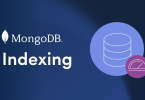Here we show how to use Mongoose to save data to a MongoDB.
(This article is part of our MongoDB Guide. Use the right-hand menu to navigate.)
What is Mongoose?
In this example, we will use NodeJS. Do not worry if you do not know NodeJS. We will explain every line of code. It is server-side JavaScript. It is a little difficult to understand at first, in part because it is asynchronous, meaning multi-threaded. So you have to use either:
- Synchronous functions only
- Callbacks
Otherwise when you do statement n, statement n+1 will run right away too. So you can be, for example, processing a text file before you have read it completely.
Mongoose is an API on top of an API. It makes using the MongoDB NodeJS API easier to use.
Prerequisites
First, you need NodeJS version 6 or higher. Then install mongoose like this:
npm install mongoose
Sample Data
We will use data on smokers from the CDC (Center for Disease Control). Download that like this:
wget https://chronicdata.cdc.gov/views/wsas-xwh5
This dataset is a survey of smokers. We are only interested in the part of the data that shows which states have the most smokers (i.e., certain cachedContents JSON sections). That section looks like this:
{
"id" : 320867377,
"name" : "LocationDesc",
"dataTypeName" : "text",
"description" : "Location description",
"fieldName" : "locationdesc",
"position" : 3,
"renderTypeName" : "text",
"tableColumnId" : 20084901,
"width" : 109,
"cachedContents" : {
"largest" : "Wyoming",
"non_null" : 14069,
"null" : 0,
"top" : [ {
"item" : "North Carolina",
"count" : 20
}, {
"item" : "North Dakota",
"count" : 19
}, {
"item" : "Ohio",
"count" : 18
Now, open the mongoDB CLI and create the tobacco database and smokers collection:
mongo
use tobacco
db.createCollection("smokers")
Below we explain the code. At the end is the entire program so that you can copy and paste it.
First we connect to MongoDB:
var mongoose = require('mongoose');
mongoose.connect('mongodb://localhost/tobacco', { useMongoClient: true });
mongoose.Promise = global.Promise;
Next we create a schema. A schema is not required. One thing about MongoDB is you can put any kind of JSON in it and it will store it. But a schema lets you define your own validation rules. The schema too can include all kind of cool items like functions too.
As you can see, cachedContents is the part of the JSON document we are interested in. And top is an array.
var schema = new mongoose.Schema({
cachedContents : {
largest : String,
non_null : Number,
null : Number,
top : [{
item : String,
count : Number
}],
smallest : String,
format : {
displayStyle : String,
align : String
}
}
});
We then compile the schema into a model like this:
var Smokers = mongoose.model('smokers', schema);
Read the JSON string data (fs.readFileSync) into a JSON JavaScript object (using JSON.parse). Notice that we use fs.readFileSync (i.e,. synchronous) instead of fs.readFile so that the next sections of code will wait until the read is complete.
fs = require('fs');
var d = fs.readFileSync('/home/walker/Documents/mongodb/tobacco.json', 'utf8', (err, data) => {
if (err) throw err;
return (d); });
var e = JSON.parse(d);
Next is the most complex part. The tobacco JSON file is two levels of JSON. So we have a loop inside a look. Then we refer to cachedContents part of the JSON object using e.columns[i,j].cachedContents. We only want those records with e.columns[i,j].cachedContents.top, i.e., top is defined. (The other ones are geolocation data.)
We supply the e.columns[i,j].cachedContents to the constructor for the Smokers schema. Then we use the save method. Save runs asynchronously. But we don’t care about that as it comes at the end of the program.
for (i in e) {
for (j in i) {
if (e.columns[i,j].dataTypeName != 'location') {
if (typeof(e.columns[i,j].cachedContents.top) != 'undefined') {
var smokers = new Smokers(e.columns[i,j].cachedContents);
console.log(e.columns[i,j].cachedContents);
smokers.save(function (err) {
if (err)return console.log(err);
})
}
}
}
}
The Complete Code
Copy and save this as loaddata.js. Then run it using: node loaddata.js. Notice there is no main or anything like that. It just runs top-to-bottom.
fs = require('fs');
var mongoose = require('mongoose');
mongoose.connect('mongodb://localhost/tobacco', { useMongoClient: true });
mongoose.Promise = global.Promise;
var schema = new mongoose.Schema({
cachedContents : {
largest : String,
non_null : Number,
null : Number,
top : [{
item : String,
count : Number
}],
smallest : String,
format : {
displayStyle : String,
align : String
}
}
});
var d = fs.readFileSync('/home/walker/Documents/mongodb/tobacco.json', 'utf8', (err, data) => {
if (err) throw err;
return (d); });
var e = JSON.parse(d);
var Smokers = mongoose.model('smokers', schema);
for (i in e) {
for (j in i) {
if (e.columns[i,j].dataTypeName != 'location') {
if (typeof(e.columns[i,j].cachedContents.top) != 'undefined') {
var smokers = new Smokers(e.columns[i,j].cachedContents);
console.log(e.columns[i,j].cachedContents);
smokers.save(function (err) {
if (err)return console.log(err);
})
}
}
}
}
As saved record will look something like this:
{ largest: 'Wyoming',
non_null: 14069,
null: 0,
top:
[ { item: 'North Carolina', count: 20 },
{ item: 'North Dakota', count: 19 },
{ item: 'Ohio', count: 18 },
{ item: 'Oklahoma', count: 17 },
{ item: 'Oregon', count: 16 },
{ item: 'Pennsylvania', count: 15 },
{ item: 'Puerto Rico', count: 14 },
{ item: 'Rhode Island', count: 13 },
{ item: 'South Carolina', count: 12 },
{ item: 'South Dakota', count: 11 },
{ item: 'Tennessee', count: 10 },
{ item: 'Texas', count: 9 },
{ item: 'Utah', count: 8 },
{ item: 'Vermont', count: 7 },
{ item: 'Virginia', count: 6 },
{ item: 'Washington', count: 5 },
{ item: 'West Virginia', count: 4 },
{ item: 'Wisconsin', count: 3 },
{ item: 'Wyoming', count: 2 },
{ item: 'Indiana', count: 1 } ],
smallest: 'Alabama' }
Tips
As you work with this you can delete and then show objects as shown below. Remove requires a filter. {} is a filter meaning all records. You use db instead of tobacco to denote the database. And smokers is the collection. And if you spell anything wrong it does not give you an error as it assumes you want to create a new object. (JavaScript is like that too as it has no error checking with regards to spelling variable names.)
sse tobacco
db.smokers.remove({})
db.smokers.find({}).pretty()
And then you can step through the data like this with the interactive node interpreter (i.e., run node and then paste in whatever code you want to study:
for (i in e) { for (j in i) {"i=",i,"j=",j,console.log(e.columns[i,j].cachedContents) }}
Additional Resources
Mongoose: MongoDB object modelling for Node.js from Yuriy Bogomolov
These postings are my own and do not necessarily represent BMC's position, strategies, or opinion.
See an error or have a suggestion? Please let us know by emailing blogs@bmc.com.






